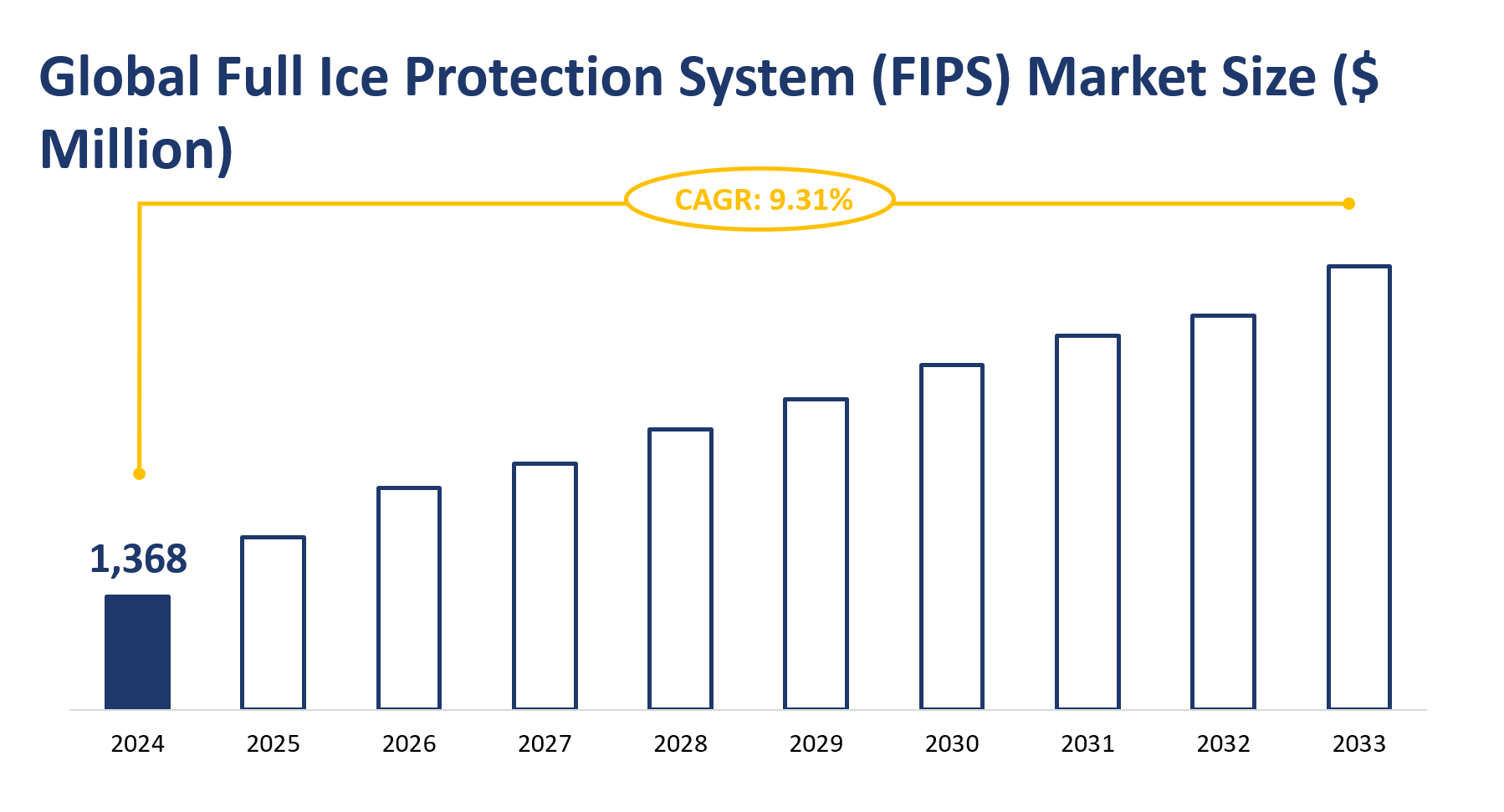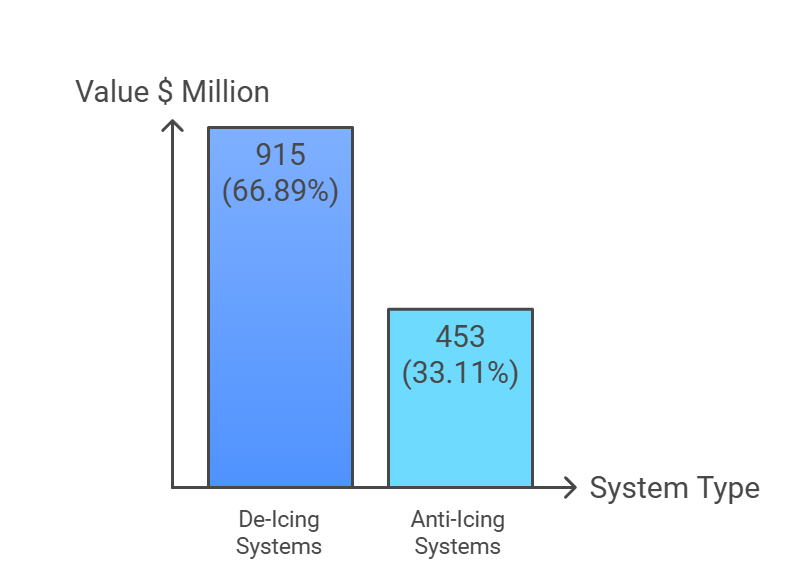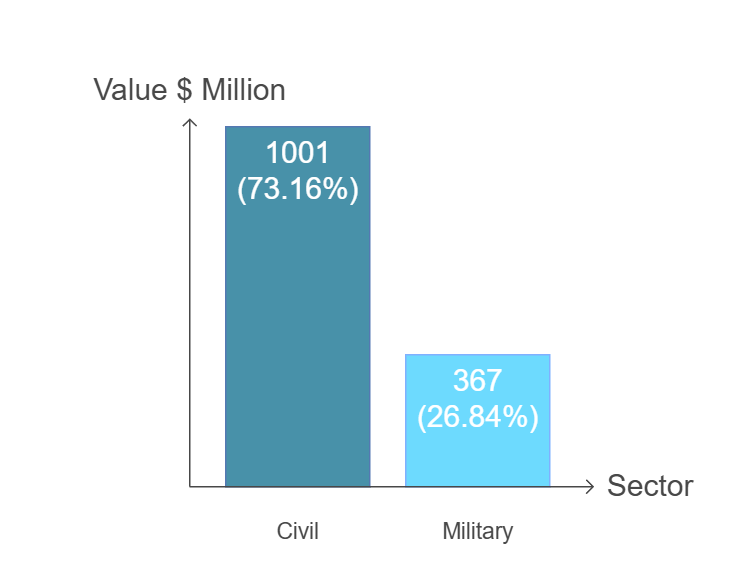1. Full Ice Protection System (FIPS) Market Scope
The Full Ice Protection System (FIPS) market is anticipated to experience significant growth in the coming years, with a Compound Annual Growth Rate (CAGR) of 9.31% during 2024-2033. For the year 2024, the total global FIPS value is projected to reach 1,368 million USD, marking a substantial increase from previous years. The FIPS is a critical technology designed to prevent airplanes from icing during flight, ensuring safe continuation of missions in known icing conditions. It encompasses ice detection, engine anti-icing, de-icing of main and tail rotor blades, vents, and windshield heating, finding applications primarily in transportation and rescue missions.
Figure Global Full Ice Protection System (FIPS) Market Size (M USD) and CAGR 2024-2033

2. Drivers and Limitations of Full Ice Protection System (FIPS) Market
The growth of the FIPS market is propelled by several factors. Increased aircraft deliveries and growing aviation demand have been significant, with a record number of commercial aircraft orders placed in 2023, indicating a robust market. Additionally, heightened requirements for flight safety from passengers and regulations have made FIPS indispensable, especially in regions prone to icing conditions. However, the market faces challenges such as the environmental impact of de-icing methods and regulatory constraints that can hinder the adoption of new technologies. The disadvantages of current de-icing methods, including their limited protection and the environmental damage caused by chemical discharges, pose a threat to the industry’s sustainability. Moreover, regional conflicts, inflation, economic recession, or uncertainty due to climate change could impact the aviation industry and limit investment in FIPS systems.
3. Technological Innovations and Corporate Mergers and Acquisitions in FIPS Market
The FIPS market has witnessed notable technological progress and product innovation. Introductions such as new de-icing procedures, materials, and advanced technologies like robotic cleaning machines have improved aircraft safety while reducing maintenance costs. Electrically powered anti-icing systems have increased energy efficiency, and digital measurement of snow and precipitation is becoming more prevalent. Innovations like the bio-derived de-icing fluid and the world’s largest de-icing robot at Avinor Oslo Airport highlight the industry’s move towards sustainability and technological advancement.
Corporate activities, including mergers and acquisitions, have also shaped the market. Notable examples include Parker Hannifin Corporation’s acquisition of Meggitt PLC, strengthening the former’s position in aerospace and defense, and ITT Inc.’s acquisition of Svanehøj, enhancing its Industrial Process segment.
4. Major Types of Full Ice Protection System (FIPS) Analysis
The FIPS market is segmented by type, with De-Icing Systems and Anti-Icing Systems being the two primary categories.
In 2024, De-Icing Systems are forecasted to account for a dominant share of the market, with a revenue of 915 million USD. Anti-Icing Systems, while starting at a lower point with 453 million USD in 2024. De-Icing Systems, designed to remove existing ice, are crucial for ensuring immediate safety during flight, while Anti-Icing Systems focus on the continuous prevention of ice formation, minimizing aerodynamic penalties.
The market share of de-icing systems is expected to be 66.89% in 2024. These systems are an integral part of aircraft safety, and de-icing systems continue to dominate as they can be immediately and effectively de-iced, which is a key factor in ensuring flight safety.
Figure Global Full Ice Protection System (FIPS) Market Value and Share by Type in 2024

5. Major Applications of Full Ice Protection System (FIPS) Analysis
The Full Ice Protection System (FIPS) market is segmented into two primary applications: Civil and Military. In 2024, the Civil segment is projected to dominate the market, with an estimated revenue of $1,001 million USD, reflecting the significant demand for FIPS in commercial aviation. This segment encompasses commercial airlines, private aircraft, and helicopters that operate under various weather conditions for passenger and cargo transportation, entertainment, and other purposes. The Civil application is expected to maintain a strong market share, with a forecasted 73.16% of the total FIPS market in 2024, indicating the civilian sector’s reliance on reliable ice protection systems for safe operations.
On the other hand, the Military segment is anticipated to generate $367 million USD in 2024. Military applications include fixed-wing aircraft, helicopters, and unmanned aerial systems operated by armed forces for combat, reconnaissance, transport, aerial refueling, and search and rescue missions. Despite the smaller market share of 26.84% in 2024, the Military segment is crucial for ensuring the safety and effectiveness of military operations in adverse weather conditions. The FIPS in military aircraft plays a vital role in maintaining the performance and safety of these assets, especially in regions with harsh winter conditions or high-altitude operations where icing is a significant risk..
Figure Global Full Ice Protection System (FIPS) Market Value and Share by Application in 2024

6. Global Full Ice Protection System (FIPS) Market Analysis by Region
The global FIPS market is distributed across various regions, with North America, Europe, Asia-Pacific, Latin America, and the Middle East and Africa each contributing to the market’s growth. In 2024, North America is expected to lead with a revenue of $532 million USD, followed by Europe with $688 million USD. The Asia-Pacific region is projected to generate $66 million USD, while Latin America and the Middle East and Africa are estimated at $79 million USD and $4.3 million USD, respectively.
North America’s dominance can be attributed to the presence of major aircraft manufacturers and the well-established aviation industry, which demands advanced ice protection systems for both civilian and military operations. Europe, with its significant aerospace industry and strict aviation safety regulations, also contributes substantially to the FIPS market. The Asia-Pacific region, despite its smaller market size, is expected to experience growth due to the increasing number of air passengers and the expansion of both commercial and military aviation in countries like China, Japan, and India.
Latin America, though currently holding a smaller share, is expected to see growth in the FIPS market due to the need for advanced aircraft systems in countries like Brazil, which is a significant player in the region’s aviation sector. The Middle East and Africa, while having the smallest market size, may experience market expansion driven by the need for advanced aviation technology in the face of harsh weather conditions and the growing demand for air travel and cargo transport in the Middle East.
Overall, the FIPS market’s regional distribution reflects the global aviation industry’s structure, with developed regions leading in market size and emerging economies showing potential for future growth. The FIPS market is influenced by regional aviation industry development, weather conditions, and the demand for safe and efficient air travel..
Table Global Full Ice Protection System (FIPS) Market Revenue (M USD) and Share by Region in 2024
| Revenue | Revenue Share |
North America | 532 | 38.86% |
Europe | 688 | 50.27% |
Asia-Pacific | 66 | 4.79% |
Latin America | 79 | 5.77% |
Middle East & Africa | 4.3 | 0.31% |
7. Global Full Ice Protection System (FIPS) Market Analysis by Key Players
7.1 UTC Aerospace Systems
Company Profile: UTC Aerospace Systems, established in 2012 and headquartered in the USA, is a leading provider of critical ice protection solutions for the all-weather operation of high-performance aircraft. The company, formed from the merger of Hamilton Sundstrand and Goodrich Corporation, offers a comprehensive range of products including Goodrich FASTboot® and Goodrich SILVERboot™ pneumatic deicers, DuraTherm® electrothermal ice protection, and heating products, rotor ice protection systems (RIPS), windshield heat controllers, and wiper systems.
Business Overview: Collins Aerospace, a part of UTC, is recognized for its ice detection and protection systems, catering to regional, business, general aviation, and military aircraft platforms. The company’s solutions cover all aspects of de-icing system development, from design and manufacture to qualification, certification, and aftermarket support.
Product Offered: UTC Aerospace Systems provides Goodrich De-Icing Systems, known for their engineering excellence over 90 years. Their products are custom designed for each aircraft to optimize ice shed performance and minimize intercycle ice.
Financial Performance: In 2023, UTC Aerospace Systems reported a revenue of $236.54 million USD and a gross margin of 41.73%. Projected for 2024, the company is expected to achieve a revenue of $276.68 million USD with a gross margin of 43.39%.
7.2 Honeywell
Company Profile: Honeywell, established in 1885 and headquartered in the USA, is a Fortune 500 company known for inventing and manufacturing technologies to address global macrotrends such as safety, security, and energy. With approximately 110,000 employees worldwide, Honeywell’s products and services are utilized in virtually every commercial, defense, and space aircraft.
Business Overview: Honeywell builds aircraft engines, cockpit and cabin electronics, wireless connectivity systems, and more. The company offers energy-efficient products, specialty chemicals, process technologies, and advanced materials, among others. Honeywell is also a leading provider of management and technical services, repair, overhaul, and maintenance services.
Product Offered: Honeywell specializes in anti-ice valves that improve flight safety by preventing ice buildup on engine cowl and flight control surfaces. They also offer air management solutions that control cabin temperature and air flow, providing secondary cooling for avionics.
Financial Performance: Honeywell reported a revenue of $84.65 million USD in 2023 with a gross margin of 35.58%. For 2024, the company is projected to achieve a revenue of $94.14 million USD and a gross margin of 40.21%.
7.3 Safran
Company Profile: Safran, established in 2005 and headquartered in France, operates in the aviation, defense, and space markets. The company is known for its high-technology solutions that contribute to a safer and more sustainable world. With 92,000 employees, Safran holds leadership positions in its core markets and is committed to R&D programs that maintain environmental priorities.
Business Overview: Safran provides helicopter turbines, mechanical, and electromechanical equipment. It designs, develops, manufactures, and markets equipment for civil and military aircraft, defense and security equipment, navigation equipment, and more. Safran also develops inertial navigation systems for various applications and flight control actuators for helicopters.
Product Offered: Safran offers de-icing, anti-icing protection, and ice detection systems that ensure flight safety, reduce energy consumption, and lower pilot workload. Their solutions include pneumatic and electrical options for detecting and protecting against icing, managing the protection system for wings, blades, and engine intake.
Financial Performance: In 2023, Safran reported a revenue of $189.59 million USD with a gross margin of 42.70%. For 2024, the company is expected to achieve a revenue of $206.15 million USD and a gross margin of 43.01%.
Table Global Full Ice Protection System (FIPS) Revenue (M USD) of Key Players in 2024
| Share | Revenue |
UTC Aerospace Systems | 20.22% | 276.68 |
Safran | 15.06% | 206.15 |
Honeywell | 6.88% | 94.14 |





